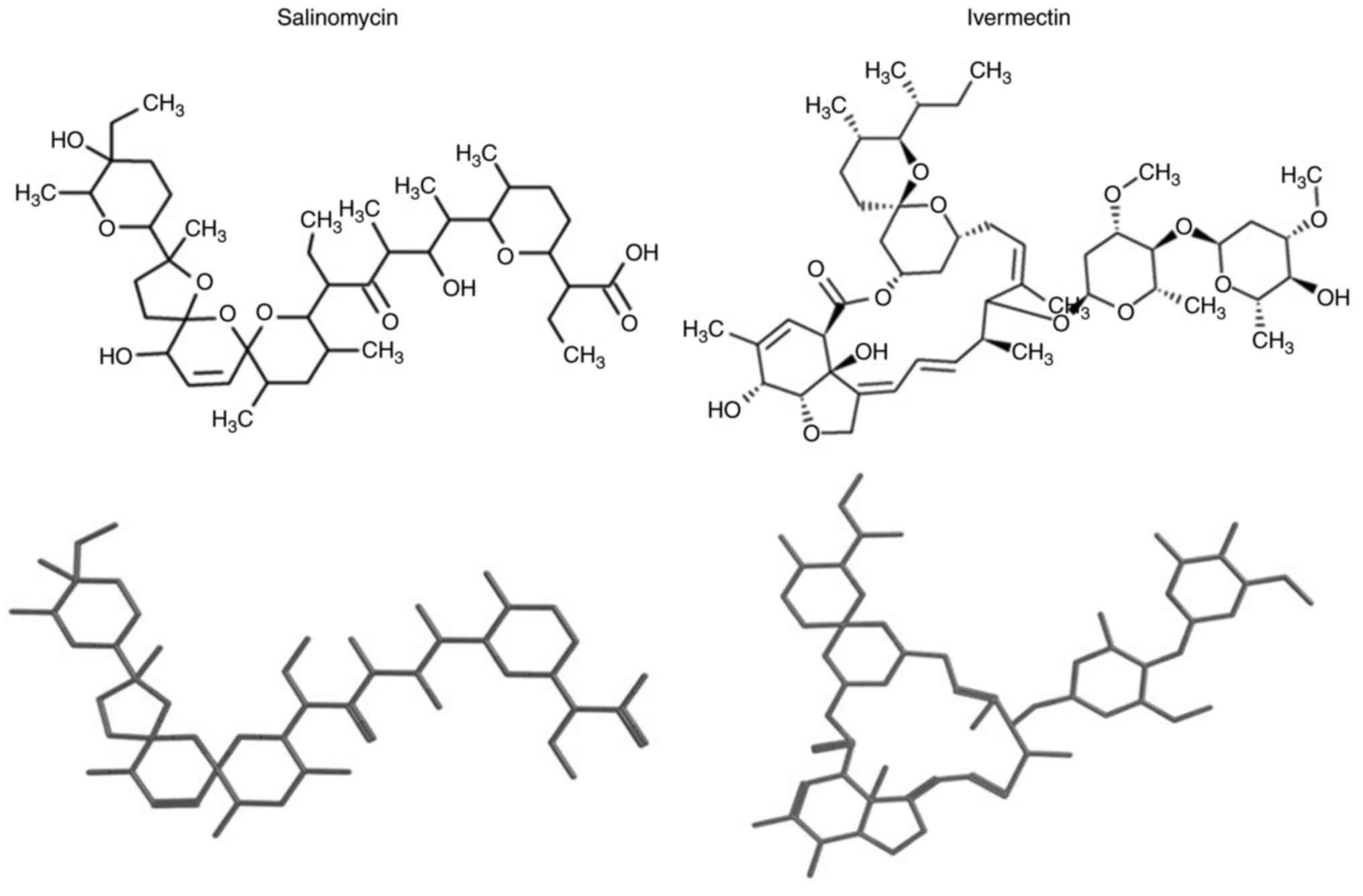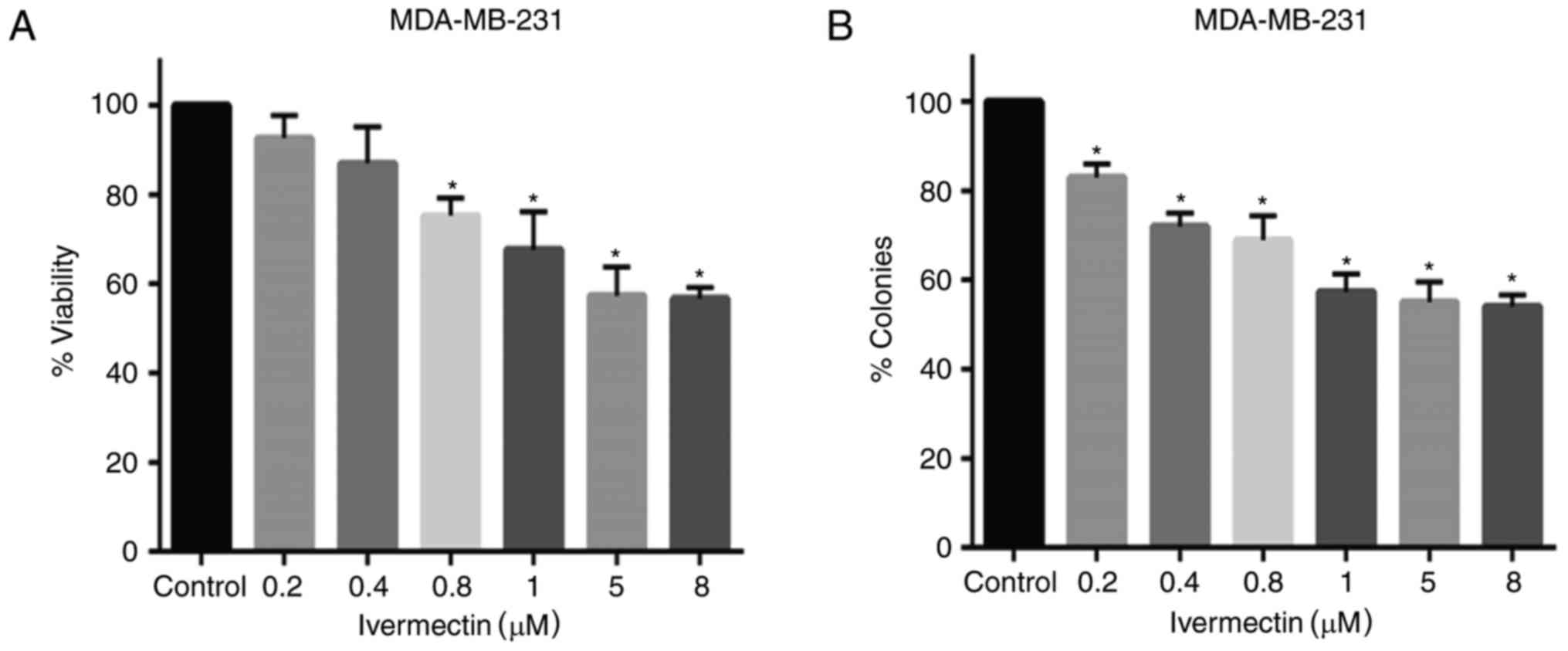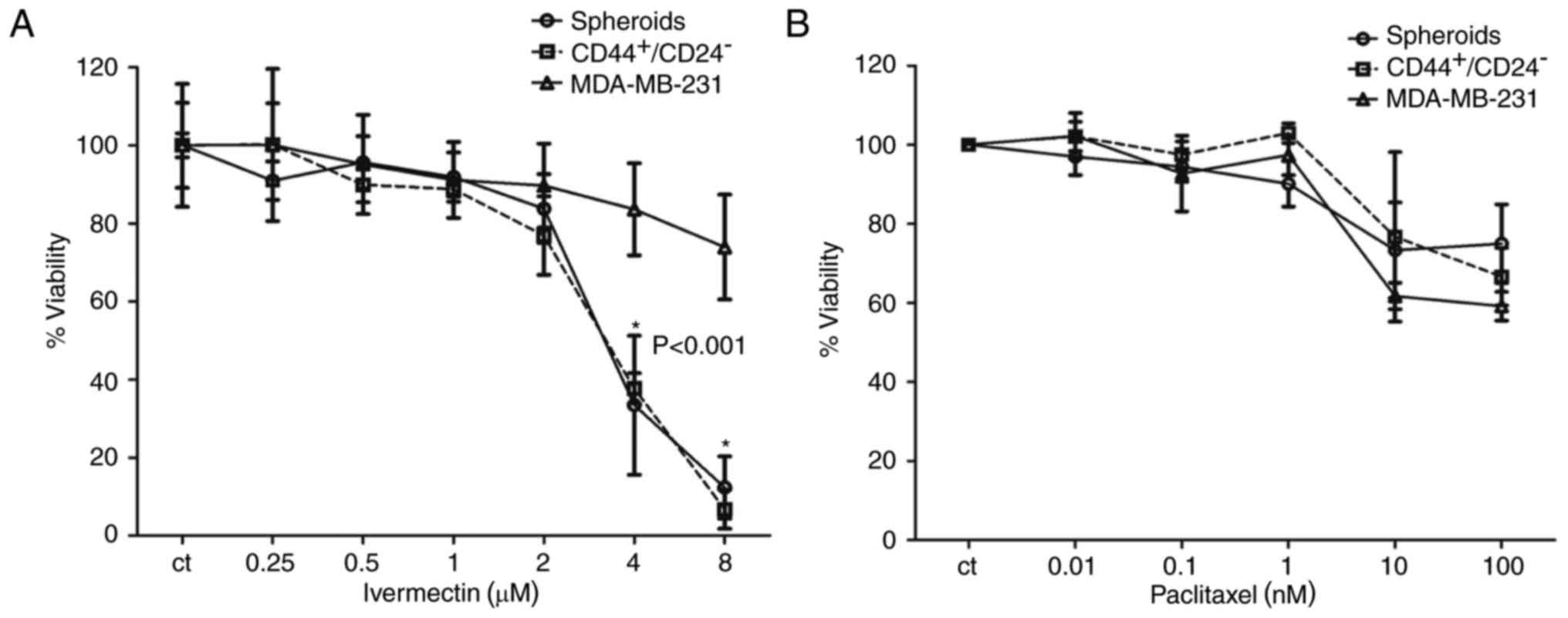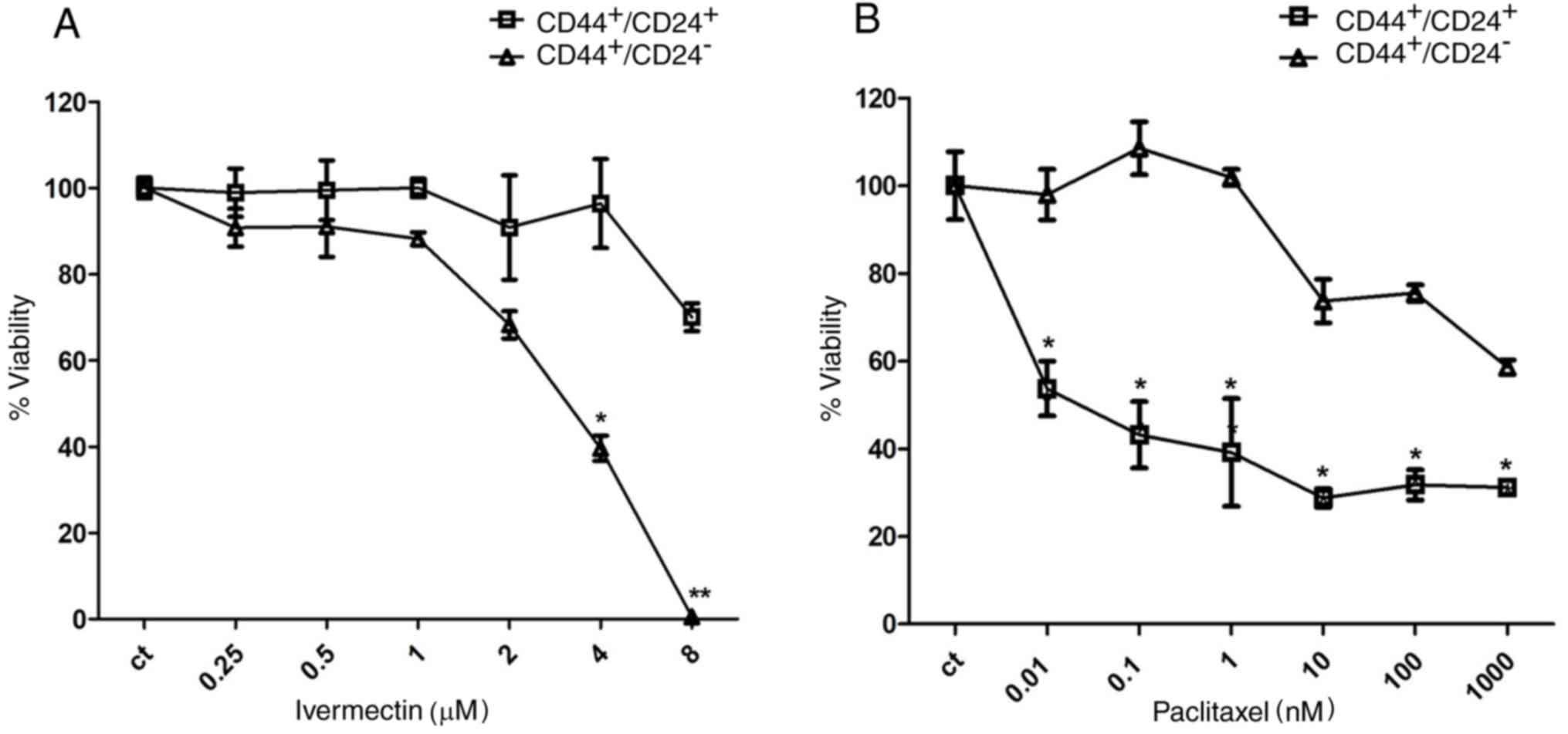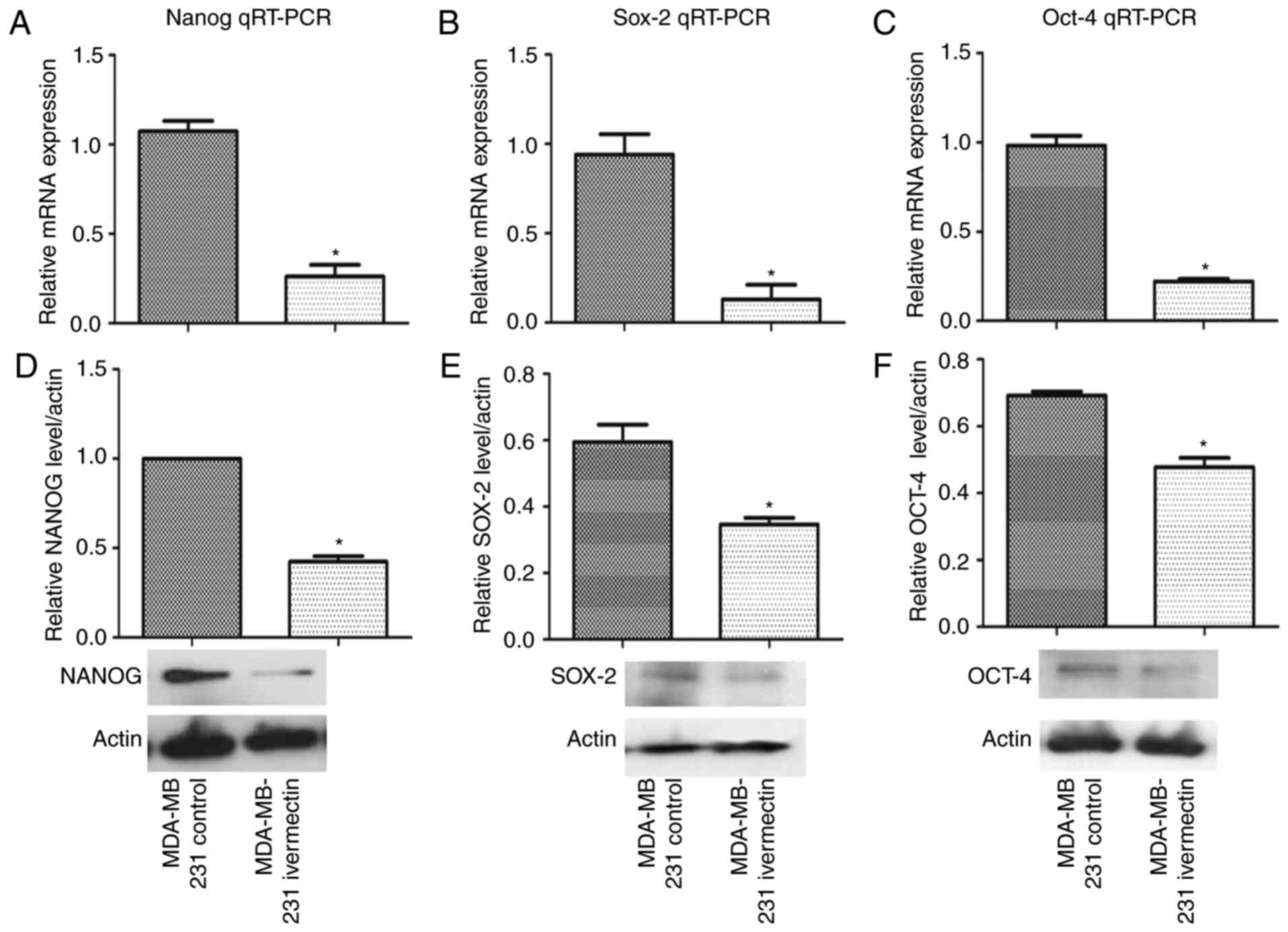Ivermectin as an inhibitor of cancer stem‑like cells
- Authors:
- Published online on: December 8, 2017 https://doi.org/10.3892/mmr.2017.8231
- Pages: 3397-3403
Abstract
Introduction
Ivermectin, a polycyclic lactone pesticide produced by bacterium Streptomyces avermitilis is a broad-spectrum antiparasitic drug that has been used in human medicine since 1987 (1). It is the drug of choice in treating onchocerciasis and strongyloidiasis, and as a therapeutic option for mass population treatment campaigns for lymphatic filariasis. As a microfilaricide, a single dose of ivermectin is fast, effective and well tolerated, and causes little to no severe inflammatory responses (2). Commonly observed adverse effects from treatment with ivermectin are mild and self-limiting and include: Skin reactions (such as itching), musculoskeletal pain, fever, swelling of the face, joints and limbs, headaches and dizziness, lymphadenopathy, eye reactions and pain from parasitic nodules (3).
Previous studies on the molecular pathogenesis of cancer has improved our knowledge and increased interest in repurposing non-cancer drugs to be used against this disease (4). A study from 1996 reported that ivermectin treatment in murine multidrug-resistant (MDR)-P388 and human MDR-CEM leukemia cells was a substrate and inhibitor of P-glycoprotein-mediated multidrug resistance in cancer (5). Another study demonstrated that ivermectin, at doses of 3–5 mg/kg, was able to suppress the growth of human melanoma and a number of other cancer xenografts in mice without adverse effects (6). In 2009, a high-throughput screen was performed to identify the selective inhibitors of cancer stem-like cells (CSCs) and demonstrated that salinomycin treatment reduced the proportion of CSCs by >100-fold relative to paclitaxel, inhibited mammary tumor growth in vivo and increased epithelial differentiation of tumor cells, accompanied by a loss of expression of breast CSC genes (7). As salinomycin is an antiparasitic drug for veterinary use only, similar compounds for human use were investigated that may also act as selective inhibitors of CSC. The results of the present study demonstrated that ivermectin exhibits a high degree of similarity with salinomycin and preferentially inhibited the CSC subpopulation in a breast cancer model.
Materials and methods
Computational searches
To systematically identify FDA approved drugs that exhibit similar activity as salinomycin, a fast computational search of the DrugBank database 4.0 of approved drugs was performed (8). Using the principles of similarity searching with two-dimensional fingerprints, the chemical structure of salinomycin was used as a query to compute the similarity of each of 1,623 compounds in DrugBank using the Molecular ACCess System keys (9) and the Tanimoto coefficient (10), as implemented in Molecular Operating Environment (version 2010.10) (11). The selection of hit compounds was based on similarity values and visual inspection.
Cell culture and drugs
The breast cancer cell line MDA-MB-231 was obtained from the American Type Culture Collection (Manassas, VA, USA). Cells were cultured in Dulbecco's modified Eagle's medium (DMEM)/F12 medium supplemented with 10% of fetal bovine serum (FBS) (both from Invitrogen; Thermo Fisher Scientific, Inc., Waltham, MA, USA) at 37°C in a humidified 5% CO2 atmosphere. Ivermectin and paclitaxel were purchased from Sigma-Aldrich (Merck KGaA, Darmstadt, Germany).
Cell viability assay
Cells were seeded (2×103 cells/well) into 96-well microplates (Corning Incorporated, Corning, NY, USA) into 0.1 ml of medium at 37°C for 24 h, and then treated with either ivermectin (0.2, 0.4, 0.8, 1, 5 or 8 µM) or paclitaxel (0.001, 0.1, 10 or 1,000 nM) for 72 h at 37°C. The medium was replaced with fresh medium containing drug or vehicle daily. Equal volumes of ethanol and DMSO vehicles were used for ivermectin and paclitaxel, respectively. Cell viability was evaluated by the colorimetric assay CellTiter 96 AQueous One Solution Cell Proliferation assay (Promega Corporation, Madison, WI, USA) according to the manufacturer's protocol. Following 72 h treatment, the AQueous One Solution reagent was added and incubated for an additional 4 h at 37°C. The optical density was measured at 490 nm, using a plate reader and the effect of each treatment was expressed as a percentage of cell viability relative to the untreated control cells. Mean values and standard deviations were calculated; experiments were performed in triplicate.
Clonogenic assay
MDA-MB-231 cells (4.5×105) were plated in a 25 cm2 cell culture flask and incubated for 48 h to allow the cells to proliferate to reach a cell density of 70%. Cells were treated with different doses of ivermectin (0.2, 0.4, 0.8, 1, 5 and 8 µM) for 120 h. Control cells were treated with the corresponding amounts of ethanol (the ivermectin vehicle). After 120 h, cells were collected and cultured in drug-free medium in a dish (2 mm grid; 60×15 mm; Corning Incorporated) for 21 days. Subsequently, colonies were fixed in methanol and acetic acid (3:1 v/v), and stained with 0.4% crystal violet (Sigma-Aldrich; Merck KGaA). The number of colonies on the culture dish were counted with a stereo microscope and quantified using ImageJ software version 1.50f (National Institutes of Health, Bethesda, MD, USA).
Spheroid culture
MDA-MB-231 cells (4.5×105) were grown in a 25 cm2 cell culture flask and incubated in DMEM/F12 medium, 10% fetal bovine serum, penicillin (100 U/ml) and streptomycin (1.0 mg/ml) at 37°C in humidified atmosphere of 5% CO2 for 48 h, to allow the cells to proliferate to a confluence of ~80%. Cells were collected and sub-cultured (1×103 cells) in 24-well ultra-low attachment multiwell plates (Corning Costar; Corning Incorporated) for 15 days with 1 ml MammoCult Basal Medium plus supplements (STEMCELL Technologies, Inc., Vancouver, BC, Canada), 0.48 µg/ml hydrocortisone and 4 µg/ml heparin, at 37°C in a humidified atmosphere of 5% CO2 and 95% air. The medium was changed every 2 days. Following 15 days incubation, the spheroids (confluence, ~60–70%) were dispersed and stained with 0.4% trypan blue to assess the cell viability and counted with a TC10 Automated Cell Counter (Bio-Rad Laboratories, Inc., Hercules, CA, USA). Cells (1×103) were seeded into a 96-well plate and exposed to ivermectin (0.25, 0.5, 1, 2, 4 and 8 µM) or paclitaxel (0.1, 0.1, 1, 10 and 100 nM) for 72 h, or their respective vehicles, ethanol or DMSO.
Sorting the cluster of differentiation (CD)44+/CD24− subpopulation of MDA-MB-231 cells by flow cytometry
MDA-MB-231 cells (5×105) were seeded in 75 cm2 culture flasks and incubated in complete medium for 48 h to achieve a confluence of ~90%. Cells were washed once with PBS and then harvested with 0.05% trypsin + 0.025% EDTA. Detached cells were washed with blocking reagent (1% FBS in PBS) and resuspended in 1 ml wash buffer (1×106 cells/100 µl), containing the fluorophore-conjugated monoclonal antibodies against CD44 (fluorescein isothiocyanate-conjugated; catalog no. 555742; BD Biosciences, Franklin Lakes, NJ, USA) and against human CD24 (phycoerythrin-conjugated; catalog no. 311106; BioLegend, Inc., San Diego, CA, USA) or their respective isotype controls (FITC-IgG2bκ, catalog no. 555742; PE-IgG2aκ, catalog no. 555574; BD Biosciences). Antibodies were used at the manufacturer's recommended concentrations (dilution: 20 µg/1×106 cells in 100 µl) and incubated at 4°C in the dark for 40 min. Labeled cells were washed in the wash buffer twice. The stem cell marker profiling analysis was performed using a BD FACScanto II (BD Biosciences). Live cell sorting was performed using a BD FACSAria (BD Biosciences). The percentage of cells in different marker populations was evaluated using BD FACSDiva version 6.1.3 (BD Biosciences). The sorted cells were resuspended three times in DMEM-F12-10% FBS with 10,000 U/ml penicillin, 10 mg/ml streptomycin and 0.025 mg/ml amphotericin B. Cells were counted using the trypan blue method and seeded (1×103 cells/well) in a 96-well plate with an ultra-low attachment surface (Corning-Costar; Corning Inc.) in Human MammoCult™ Proliferation supplement (STEMCELL Technologies, Inc.), 0.48 µg/ml hydrocortisone and 4 µg/ml heparin, for 24 h at 37°C in humidified atmosphere of 5% CO2. Cells were treated with ivermectin (0.25, 0.5, 1, 2, 4 or 8 µM) or paclitaxel (0.1, 0.1, 1,10 or 100 nM) or their respective vehicle controls for 72 h. Finally, cells were stained with 0.4% trypan blue to assess cell viability and counted with TC10 Automated Cell Counter (Bio-Rad Laboratories, Inc., Hercules, CA, USA) as aforementioned.
Expression of stemness genes by reverse transcription-quantitative polymerase chain reaction (RT-qPCR)
Unsorted, whole population MDA-MB-231 cells were treated with ivermectin for 72 h and total RNA was isolated when cells reached ~70% confluence, using TRIzol reagent (Gibco; Thermo Fisher Scientific, Inc.) according to the manufacturer's protocol. RNA purity and integrity were assessed by spectrophotometric analysis using a NanoDrop 2000c (Thermo Fisher Scientific, Inc.) and denaturing 2% agarose gel; bands were visualized using a MiniBIS Pro D-Transilluminator (DNR Bio-Imaging Systems Ltd., Neve Yamin, Israel).
A total of 1 µg total RNA was used for cDNA synthesis with the GeneAmp RNA PCR Core kit (Applied Biosystems; Thermo Fisher Scientific, Inc.). cDNA was used with iQ SYBR Green SuperMix (Bio-Rad Laboratories, Inc.), according to the manufacturer's protocol. qPCR reactions were run in triplicate using an ABI Prism 7000 (Applied Biosystems; Thermo Fisher Scientific, Inc.). The qPCR cycling conditions were as follows: 10 min at 95°C; 40 cycles of 30 sec at 95°C, 30 sec at 60°C and 30 sec at 72°C. Data were analyzed using the 2−ΔΔCq method (12), and reported as the fold-change in gene expression normalized to the endogenous control gene hypoxanthine phosphoribosyltransferase 1 (HPRT1), and relative to cells without treatment. The primers used were: HPRT1 forward, 5′-GAACCTCTCGGCTTTCCCG-3′ and reverse, 3′-CACTAATCACGACGCCAGGG-5′; homeobox protein nanog (nanog) forward, 5′-ACCTCGCTGATTAGGCTCCAA-3′ and reverse, 3′-AGTCTGGACACTGGCTAATCC-5′; octamer binding protein 4 (oct-4) forward, 5′-CAGGCCCGAAAGAGAAAGC-3′ and reverse, 3′-CCACACTCGGACCACATCCT-5′; and sox-2 forward, 5′-GCTAGTCTCCAAGCGACGAAA-3′ and reverse, 3′-AATTCAGCAAGAAGCCTCTCCTT-5′. The annealing temperature was 60°C for all reactions.
Protein extraction and western blot analysis of nanog, sox-2 and oct-4
Unsorted whole population MDA-MB-231 cells (4×105) were cultured in 25 cm2 flasks and treated with ivermectin (or its vehicle control) for 72 h. Once the cells had reached a density of ~70%, the cells were washed once with PBS and then harvested with 0.05% trypsin/0.025% EDTA. Detached cells were washed with PBS, proteins were extracted with radioimmunoprecipitation buffer (150 mM NaCl; 1.0% IGEPAL CA-630; 0.5% sodium deoxycholate; 0.1% SDS; 50 mM Tris, pH 8.0) in the presence of proteinase inhibitors (catalog no. p8340; Sigma-Aldrich; Merck KGaA). Protein concentration was determined using a bicinchoninic acid assay and the integrity was assessed by coomassie staining. A total of 30 µg protein was separated by 10% SDS-PAGE and transferred onto a polyvinylidene difluoride membrane (cat no. 162-0177; Bio-Rad Laboratories, Inc.). The membrane was blocked with 3% skim milk in PBS for 1 h at room temperature and subsequently incubated with antibodies against nanog (catalog no. sc-134218; 1:500); sox-2 (catalog no. sc-17320; 1:200); oct-4 (catalog no. sc-9081; 1:200) (all from Santa Cruz Biotechnology, Inc., Dallas, TX, USA), and anti-actin peroxidase (A3854; 1:10,000; Sigma-Aldrich; Merck KGaA) in blocking solution (5% skim milk in TBS + 0.1% Tween-20), overnight at 4°C. The following secondary antibodies were used: Oct4, bovine anti-rabbit, sc-2370; sox-2, donkey anti-goat, sc-2020; nanog, anti-mouse, sc-2371 (all from Santa Cruz Biotechnology, Inc). Secondary antibodies were diluted 1:1,000 and the incubation was performed for 1 h at room temperature. Protein bands were visualized using the chromogenic substrate Clarity Western Enhanced Chemiluminescence Substrate (catalog no. 1705060; Bio-Rad Laboratories, Inc.). Bands were quantified densitometrically using Image J version 1.50f (National Institutes of Health, Bethesda, MD, USA).
Statistical analyses
Analyses were performed with GraphPad Prism software (version 6.0; GraphPad Software, Inc., La Jolla, CA, USA). The experiments were conducted with at least three independent triplicates. P-values were calculated using the one-way analysis of variance test followed by the Bonferroni post-hoc test. P<0.01 was considered to indicate a statistically significant difference.
Results
Ivermectin exhibits high structural similarity to salinomycin
Compounds identified in DrugBank possessed a low molecular similarity with salinomycin (median and mean similarity values of 0.34±0.14). Subsequent results from the similarity searching using salinomycin as a query molecule identified 25 top-ranked compounds with a high similarity value. To define a compound with ‘high’ similarity value, molecules were selected as those with similarity values two standard deviations above the mean similarity of all DrugBank compounds to salinomycin. Following visual inspection of the chemical structures of the identified compounds, the drugs with the highest similarity scores were ivermectin followed by natamycin (a food preservative) and narasin (an antibiotic for veterinary use). Ivermectin had the highest similarity value of 0.78, and following the principle of molecular similarity, which states that similar compounds demonstrate similar properties (13) (with the exception of the so-called activity cliffs) (14), it was hypothesized that the antiparasitic drug ivermectin may also possess similar biological properties as salinomycin. In addition, ivermectin is a Food and Drug Administration (FDA)-approved drug for clinical use, whereas natamycin and narasin are not. Notably, using this method of screening that is based on structural similarity rather than biological activity upon CSC cells, as reported by Gupta et al (7), did not identify avermectin as a candidate compound. Two- and three-dimensional structures of salinomycin and ivermectin are provided in Fig. 1.
Ivermectin partially inhibits cell viability and clonogenic capacity
To evaluate the antitumoral effects of ivermectin on MDA-MB-231 cells, cell viability and clonogenicity was evaluated. A mild-to-moderate dose-dependent effect was observed in cells treated with various concentrations of ivermectin (Fig. 2A); however, cell viability did not decrease beyond 45%, even at 8 µM of ivermectin. Statistically significant differences were observed at concentrations between 0.8 and 8 µM, compared with untreated controls (P<0.0001). Colony forming ability was also significantly reduced with ivermectin treatment with doses as low as 0.2 µM (Fig. 2B); however, these effects appear to be similar at doses between 1 and 8 µM (P<0.0001).
Inhibitory effects of ivermectin and paclitaxel in stem cell enriched MDA-MB-231 cells
The CD44+/CD24− subpopulation of MDA-MB-231 cells has been previously reported to possess stem/progenitor cell properties, and this subpopulation in patients with breast cancer exclusively retains the ability to form novel tumors in a non-obese diabetic-severe compromised immunodeficiency mouse xenograft model (15,16). The proportion of CD44+/CD24− cells in the cell line MDA-MB-231 is 85±5% (17). In addition, spheroids of cell lines growing in nonadherent conditions are also reported to be enriched in stem cells (18). Therefore, these two conditions were used to determine whether ivermectin treatment preferentially inhibited the CSC population compared with treatments with the cytotoxic drug paclitaxel. At concentrations ≤2 µM ivermectin, there were no significant differences in viability in the total MDA-MB-231 population compared with cultures of cells grown in spheroids and those sorted by CD44+/CD24− (Fig. 3A). However, cells treated with 4 or 8 µM ivermectin exhibited a significant decrease in viability in the CSC-enriched populations compared with the total cell population (P<0.001); whereas viability in the total cell population was inhibited by ≤30%. As expected, the two subpopulations (spheroids and CD44+/CD24−) exhibited less inhibition with paclitaxel treatments compared with ivermectin treatments, and no significant differences were identified between either of these groups compared with the inhibition exhibited in the total MDA-MB-231 cell population (Fig. 3B). Ivermectin treatment exhibited an increased inhibitory effect upon CSC-enriched subpopulations compared with cells treated with paclitaxel.
To further evaluate the relative selectivity of ivermectin upon the stem cell population, CD44+/CD24− and CD44+/CD24+ subpopulations of MDA-MB-231 cells were sorted and cultured in the presence of either ivermectin or paclitaxel. Cells treated with 4 and 8 µM ivermectin exhibited a significant reduction in viability of the CD44+/CD24− stem cell population; 8 µM ivermectin treatment reduced the CD44+/CD24− viability to 0%, compared with CD44+/CD24+ cells (Fig. 4A), whereas the reduction in viability in CD44+/CD24+ cells treated with 8 µM ivermectin approached 25%. The non-CSC CD44+/CD24+ cell populations were sensitive to paclitaxel from 0.01 nM; whereas inhibition of the CD44+/CD24− stem cell subpopulation was only observed at ≥10 nM. Statistical differences were observed at all concentrations between CD44+/CD24+ and CD44+/CD24− (Fig. 4B).
Ivermectin reduces the expression of stemness genes
As salinomycin has been demonstrated to decrease the expression of stemness genes including nanog (19), MDA-MB-231 cells cultured in normal (adherent) conditions were treated with ivermectin at 4 µM for 72 h and the mRNA expression levels of nanog, sox-2 and oct-4 were evaluated by RT-qPCR and western blotting. As demonstrated in Fig. 5, ivermectin significantly reduced the expression of these three genes at both the mRNA and the protein level (P<0.01).
Discussion
In the field of drug repurposing for cancer therapy, major efforts have been undertaken to identify drugs that may selectively or preferentially target the CSC population of tumors. The results of the present study demonstrated that ivermectin, an antiparasitic drug for approved for human use, preferentially targeted the CSC-enriched subpopulation of the breast cancer cell line MDA-MB-231. Higher reductions in cell viability were observed for the CD44+/CD24− subpopulation and spheroids treated with ivermectin compared with paclitaxel. These results were accompanied by the decreased expression of stemness genes nanog, sox-2 and oct-4, previously reported to be highly expressed in CSCs (20).
Failure to successfully eradicate tumors no longer amenable to local treatments is at least partly due to the existence of CSCs, which are characterized by tumorigenic properties, such as self-renewal, formation of differentiated progeny and development of resistance to therapy (21). It has been established that Notch, hedgehog (Hh) and Wnt signaling pathways are involved in the regulation of proliferation and differentiation of CSCs; therefore, these pathways may be key targets for the development of more efficient cancer therapeutics (22). However, the development of drugs that target crucial steps in the Wnt, Notch and Hh signaling pathways may not be effective or can be toxic, owing to the signaling crosstalk among these pathways. An alternative strategy may be to look in an unbiased and systematic manner at pharmacological entities that demonstrate preferential toxicity in CSCs over the total tumoral cell population (7,23). A previous study performed a screen for agents with epithelial CSC-specific toxicity and identified four compounds that consistently reduced the proportion of CSCs, including salinomycin, etoposide, abamectin and nigericin (7). Among these, salinomycin was the most effective, exhibiting a >100-fold reduction in viability compared with paclitaxel. Further investigation demonstrated that salinomycin inhibited mammary tumor growth in vivo and induced an increase in epithelial differentiation of tumor cells, which is associated with the loss of stemness genes (7). That salinomycin is currently only approved for veterinary use, prompted the authors of the present study to search for drugs approved for human use by screening DrugBank to identify structurally similar, clinically approved drugs. The results of the present study adhered to the principle of molecular similarity that states that similar compounds demonstrate similar properties (13,14); therefore, the antiparasitic drug ivermectin should exhibit similar biological effects to those reported for salinomycin (7,24,25). This is advantageous in terms of drug repositioning, as the clinical use of ivermectin as antiparasitic is extensive (25), therefore, clinical trials in cancer may proceed in the near future.
Avermectins are 16-membered pentacyclic lactone compounds that are derived from polyketides and are linked to a disaccharide of the methylated deoxysugar L-oleandrose (26). Ivermectin was FDA-approved for human use in 1987 (http://www.centerwatch.com/drug-information/fda-approved-drugs/drug/250/stromectol-ivermectin), and is an avermectin derivative of major interest as a parasitic drug, and is a mixture of 80% 22,23-dihydro-avermectin-B1a and 20% of the -B1b homolog (27). As ivermectin is an ionophore, it induces chloride-dependent membrane hyperpolarization and apoptosis in leukemia (28) and induces mitochondrial dysfunction and oxidative stress (29). The antitumor effects of ivermectin have also been associated with its ability to inactivate the p21-activated kinase 1/protein kinase B axis, inducing cytostatic autophagy and modulation of P2X purinoceptor (P2X) 4/P2X7/Pannexin-1 sensitivity to extracellular adenosine triphosphate (30,31). Ivermectin was first investigated as an antitumor drug in 1999 (32) and, to the best of the of our knowledge, no studies have been performed on its ability to preferentially target CSCs. A previous study demonstrated that ivermectin treatment inhibits the Wnt-transcription factor 4 signaling pathway (33), which is frequently considered to be altered in CSCs (21). Recently, it was demonstrated that ivermectin downregulated the expression of stemness genes nanog and sox2, in addition to reducing the activity of aldehyde dehydrogenase, all of which are CSC markers (34). The results of the present study demonstrated preferential inhibition of CSC-enriched MDA-MB-231 cells treated with ivermectin, which agreed with the literature on the effects of ivermectin upon pathways and markers associated with CSCs. The present study, however, was not mechanistic; therefore, further investigations into the molecular basis responsible for the preferential cytotoxicity of ivermectin on CSCs must be pursued.
In conclusion, results from the present study demonstrated that ivermectin preferentially targeted the stem cell population in MDA-MB-231 human breast cancer cells. Ivermectin has been demonstrated to be safe, following treatment of millions of patients with onchocerciasis and other parasitic diseases, which makes it a strong candidate for further studies investigating its potential use as a repurposed drug for cancer therapy.
Acknowledgements
The present study was supported by FONSEC, National Council of Science and Technology, Mexico (grant no. 161915) and National Autonomous University of Mexico, Support Program for Research Projects on Science and Innovation (grant no. IT206611).
References
|
Stromectol cleared by the U.S. Food and Drug Administration to treat onchocerciasis. http://www.centerwatch.com/drug-information/fda-approved-drugs/drug/250/stromectol-ivermectin | |
|
Diawara L, Traoré MO, Badji A, Bissan Y, Doumbia K, Goita SF, Konaté L, Mounkoro K, Sarr MD, Seck AF, et al: Feasibility of onchocerciasis elimination with ivermectin treatment in endemic foci in Africa: First evidence from studies in Mali and Senegal. PLoS Negl Trop Dis. 3:e4972009. View Article : Google Scholar : PubMed/NCBI | |
|
Ottesen EA and Campbell WC: Ivermectin in human medicine. J Antimicrob Chemother. 34:195–203. 1994. View Article : Google Scholar : PubMed/NCBI | |
|
Dueñas-González A, García-López P, Herrera LA, Medina-Franco JL, González-Fierro A and Candelaria M: The prince and the pauper. A tale of anticancer targeted agents. Mol Cancer. 7:822008. View Article : Google Scholar : PubMed/NCBI | |
|
Didier A and Loor F: The abamectin derivative ivermectin is a potent P-glycoprotein inhibitor. Anticancer Drugs. 7:745–751. 1996. View Article : Google Scholar : PubMed/NCBI | |
|
Driniaev VA, Mosin VA, Krugliak EB, Sterlina TC, Novik TC, Ermakova NV, Kublik LN, Levitman MKh, Shaposhnikova VV and Korystov IuN: Modification of antitumor effect of vincristine by natural avermectins. Antibiot Khimioter. 49:3–5. 2004.(In Russian). PubMed/NCBI | |
|
Gupta PB, Onder TT, Jiang G, Tao K, Kuperwasser C, Weinberg RA and Lander ES: Identification of selective inhibitors of cancer stem cells by high-throughput screening. Cell. 138:645–659. 2009. View Article : Google Scholar : PubMed/NCBI | |
|
Law V, Knox C, Djoumbou Y, Jewison T, Guo AC, Liu Y, Maciejewski A, Arndt D, Wilson M, Neveu V, et al: Drugbank 4.0: Shedding new light on drug metabolism. Nucl Acids Res. 42(Database Issue): D1091–D1097. 2014. View Article : Google Scholar : PubMed/NCBI | |
|
Durant JL, Leland BA, Henry DR and Nourse JG: Reoptimization of Mdl Keys for use in drug discovery. J Chem Inf Comput Sci. 42:1273–1280. 2002. View Article : Google Scholar : PubMed/NCBI | |
|
Willett P, Barnard JM and Downs GM: Chemical similarity searching. J Chem Inf Comput Sci. 38:983–996. 1998. View Article : Google Scholar | |
|
Molecular Operating Environment (MOE), version 2010.10. Chemical Computing Group Inc.; Montreal, PQ, Canada: http://www.chemcomp.com | |
|
Livak KJ and Schmittgen TD: Analysis of relative gene expression data using real-time quantitative PCR and the 2(-Delta Delta C(T)) method. Methods. 25:402–408. 2001. View Article : Google Scholar : PubMed/NCBI | |
|
Medina-Franco JL and Maggiora GM: Molecular similarity analysisChemoinformatics for Drug Discovery. Bajorath J: John Wiley & Sons, Inc.; Hoboken, New Jersey: pp. 343–399. 2014 | |
|
Maggiora GM: On outliers and activity cliffs - why QSAR often disappoints. J Chem Inf Model. 46:15352006. View Article : Google Scholar : PubMed/NCBI | |
|
Tanaka H, Nakamura M, Kameda C, Kubo M, Sato N, Kuroki S, Tanaka M and Katano M: The Hedgehog signaling pathway plays an essential role in maintaining the CD44+CD24-/low subpopulation and the side population of breast cancer cells. Anticancer Res. 29:2147–2157. 2009.PubMed/NCBI | |
|
Al-Hajj M, Wicha MS, Benito-Hernandez A, Morrison SJ and Clarke MF: Prospective identification of tumorigenic breast cancer cells. Proc Natl Acad Sci USA. 100:pp. 3983–3988. 2003; View Article : Google Scholar : PubMed/NCBI | |
|
Sheridan C, Kishimoto H, Fuchs RK, Mehrotra S, Bhat-Nakshatri P, Turner CH, Goulet R Jr, Badve S and Nakshatri H: CD44+/CD24- breast cancer cells exhibit enhanced invasive properties: An early step necessary for metastasis. Breast Cancer Res. 8:R592006. View Article : Google Scholar : PubMed/NCBI | |
|
Piscitelli E, Cocola C, Thaden FR, Pelucchi P, Gray B, Bertalot G, Albertini A, Reinbold R and Zucchi I: Culture and characterization of mammary cancer stem cells in mammospheres. Methods Mol Biol. 1235:243–262. 2015. View Article : Google Scholar : PubMed/NCBI | |
|
Wang Y: Effects of salinomycin on cancer stem cell in human lung adenocarcinoma A549 cells. Med Chem. 7:106–111. 2011. View Article : Google Scholar : PubMed/NCBI | |
|
Zhang W, Sui Y, Ni J and Yang T: Insights into the Nanog gene: A propeller for stemness in primitive stem cells. Int J Biol Sci. 12:1372–1381. 2016. View Article : Google Scholar : PubMed/NCBI | |
|
Dragu DL, Necula LG, Bleotu C, Diaconu CC and Chivu-Economescu M: Therapies targeting cancer stem cells: Current trends and future challenges. World J Stem Cells. 7:1185–1201. 2015.PubMed/NCBI | |
|
Takebe N, Harris PJ, Warren RQ and Ivy PS: Targeting cancer stem cells by inhibiting Wnt, Notch, and Hedgehog pathways. Nat Rev Clin Oncol. 8:97–106. 2011. View Article : Google Scholar : PubMed/NCBI | |
|
Subedi A, Futamura Y, Nishi M, Ryo A, Watanabe N and Osada H: High-throughput screening identifies artesunate as selective inhibitor of cancer stemness: Involvement of mitochondrial metabolism. Biochem Biophys Res Commun. 477:737–742. 2016. View Article : Google Scholar : PubMed/NCBI | |
|
An H, Kim JY, Oh E, Lee N, Cho Y and Seo JH: Salinomycin promotes anoikis and decreases the CD44+/CD24- stem-like population via inhibition of STAT3 activation in MDA-MB-231 cells. PLoS One. 10:e01419192015. View Article : Google Scholar : PubMed/NCBI | |
|
Krotneva SP, Coffeng LE, Noma M, Zouré HG, Bakoné L, Amazigo UV, de Vlas SJ and Stolk WA: African Program for Onchocerciasis Control 1995–2010: Impact of annual ivermectin mass treatment on off-target infectious diseases. PLoS Negl Trop Dis. 9:e00040512015. View Article : Google Scholar : PubMed/NCBI | |
|
Yoon YJ, Kim ES, Hwang YS and Choi CY: Avermectin: biochemical and molecular basis of its biosynthesis and regulation. Appl Microbiol Biotechnol. 63:626–634. 2004. View Article : Google Scholar : PubMed/NCBI | |
|
Barragry TB: A review of the pharmacology and clinical uses of ivermectin. Can Vet J. 28:512–517. 1987.PubMed/NCBI | |
|
Sharmeen S, Skrtic M, Sukhai MA, Hurren R, Gronda M, Wang X, Fonseca SB, Sun H, Wood TE, Ward R, et al: The antiparasitic agent ivermectin induces chloride-dependent membrane hyperpolarization and cell death in leukemia cells. Blood. 116:3593–3603. 2010. View Article : Google Scholar : PubMed/NCBI | |
|
Liu Y, Fang S, Sun Q and Liu B: Anthelmintic drug ivermectin inhibits angiogenesis, growth and survival of glioblastoma through inducing mitochondrial dysfunction and oxidative stress. Biochem Biophys Res Comun. 480:415–421. 2016. View Article : Google Scholar | |
|
Dou Q, Chen HN, Wang K, Yuan K, Lei Y, Li K, Lan J, Chen Y, Huang Z, Xie N, et al: Ivermectin induces cytostatic autophagy by blocking the PAK1/Akt axis in breast cancer. Cancer Res. 76:4457–4469. 2016. View Article : Google Scholar : PubMed/NCBI | |
|
Draganov D, Gopalakrishna-Pillai S, Chen YR, Zuckerman N, Moeller S, Wang C, Ann D and Lee PP: Modulation of P2X4/P2×7/Pannexin-1 sensitivity to extracellular ATP via ivermectin induces a non-apoptotic and inflammatory form of cancer cell death. Sci Rep. 5:162222015. View Article : Google Scholar : PubMed/NCBI | |
|
Mosin VA, Krugliak EB, Sterlina TS, Korystov IuN, Shaposhnikova VV, Narimanov AA, Kublik LN, Levitman MKh, Viktorov AV and Driniaev VA: Cytotoxic and cytostatic effect of avermectines on tumor cells in vitro. Antibiot Khimioter. 45:10–14. 2000.PubMed/NCBI | |
|
Melotti A, Mas C, Kuciak M, Lorente-Trigos A, Borges I and Ruiz Altaba A: The river blindness drug ivermectin and related macrocyclic lactones inhibit WNT-TCF pathway responses in human cancer. EMBO Mol Med. 6:1263–1278. 2014. View Article : Google Scholar : PubMed/NCBI | |
|
Kwon YJ, Petrie K, Leibovitch BA, Zeng L, Mezei M, Howell L, Gil V, Christova R, Bansal N, Yang S, et al: Selective inhibition of SIN3 corepressor with avermectins as a novel therapeutic strategy in triple-negative breast cancer. Mol Cancer Ther. 14:1824–1836. 2015. View Article : Google Scholar : PubMed/NCBI |



